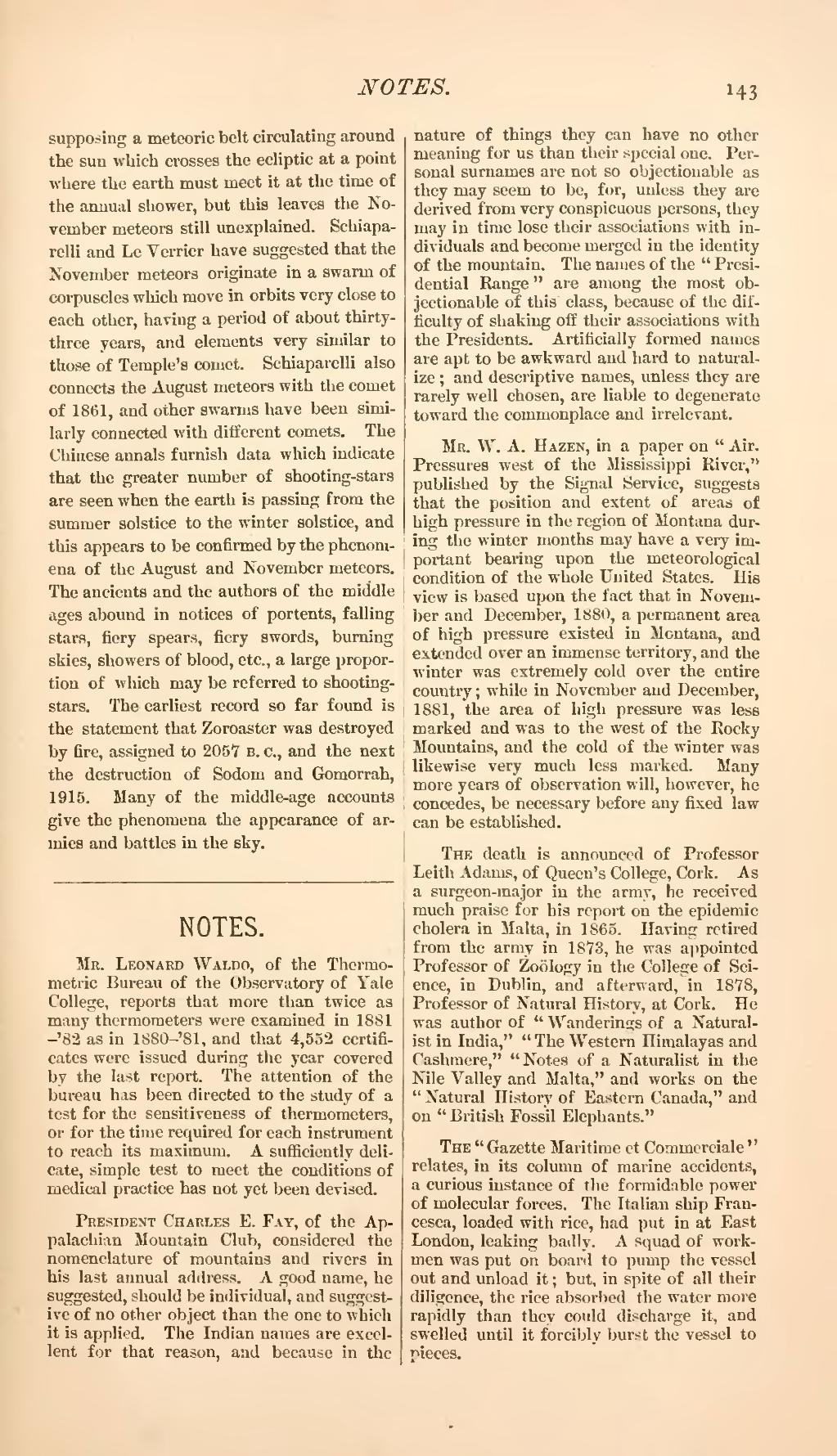supposing a meteoric belt circulating around the sun which crosses the ecliptic at a point where the earth must meet it at the time of the annual shower, but this leaves the November meteors still unexplained. Schiaparelli and Le Verrier have suggested that the November meteors originate in a swarm of corpuscles which move in orbits very close to each other, having a period of about thirty-three years, and elements very similar to those of Temple's comet. Schiaparelli also connects the August meteors with the comet of 1861, and other swarms have been similarly connected with different comets. The Chinese annals furnish data which indicate that the greater number of shooting-stars are seen when the earth is passing from the summer solstice to the winter solstice, and this appears to be confirmed by the phenomena of the August and November meteors. The ancients and the authors of the middle ages abound in notices of portents, falling stars, fiery spears, fiery swords, burning skies, showers of blood, etc., a large proportion of which may be referred to shooting-stars. The earliest record so far found is the statement that Zoroaster was destroyed by fire, assigned to 2057 b. c. and the next the destruction of Sodom and Gomorrah, 1915. Many of the middle-age accounts give the phenomena the appearance of armies and battles in the sky.
Mr. Leonard Waldo, of the Thermometric Bureau of the Observatory of Yale College, reports that more than twice as many thermometers were examined in 1881-'82~as in 1880-'81, and that 4,552 certificates were issued during the year covered by the last report. The attention of the bureau has been directed to the study of a test for the sensitiveness of thermometers, or for the time required for each instrument to reach its maximum. A sufficiently delicate, simple test to meet the conditions of medical practice has not yet been devised.
President Charles E. Fay, of the Appalachian Mountain Club, considered the nomenclature of mountains and rivers in his last annual address. A good name, he suggested, should be individual, and suggestive of no other object than the one to which it is applied. The Indian names are excellent for that reason, and because in the nature of things they can have no other meaning for us than their special one. Personal surnames are not so objectionable as they may seem to be, for, unless they are derived from very conspicuous persons, they may in time lose their associations with individuals and become merged in the identity of the mountain. The names of the "Presidential Range" are among the most objectionable of this class, because of the difficulty of shaking off their associations with the Presidents. Artificially formed names are apt to be awkward and hard to naturalize; and descriptive names, unless they are rarely well chosen, are liable to degenerate toward the commonplace and irrelevant.
Mr. W. A. Hazen, in a paper on "Air Pressures west of the Mississippi River," published by the Signal Service, suggests that the position and extent of areas of high pressure in the region of Montana during the winter months may have a very important bearing upon the meteorological condition of the whole United States. His view is based upon the fact that in November and December, 1880, a permanent area of high pressure existed in Montana, and extended over an immense territory, and the winter was extremely cold over the entire country; while in November and December, 1881, the area of high pressure was less marked and was to the west of the Rocky Mountains, and the cold of the winter was likewise very much less marked. Many more years of observation will, however, he concedes, be necessary before any fixed law can be established.
The death is announced of Professor Leith Adams, of Queen's College, Cork. As a surgeon-major in the army, he received much praise for his report on the epidemic cholera in Malta, in 1865. Having retired from the army in 1873, he was appointed Professor of Zoölogy in the College of Science, in Dublin, and afterward, in 1878, Professor of Natural History, at Cork. He was author of "Wanderings of a Naturalist in India," "The Western Himalayas and Cashmere," "Notes of a Naturalist in the Nile Valley and Malta," and works on the "Natural History of Eastern Canada," and on "British Fossil Elephants."
The "Gazette Maritime et Commerciale" relates, in its column of marine accidents, a curious instance of the formidable power of molecular forces. The Italian ship Francesca, loaded with rice, had put in at East London, leaking badly. A squad of workmen was put on board to pump the vessel out and unload it; but, in spite of all their diligence, the rice absorbed the water more rapidly than they could discharge it, and swelled until it forcibly burst the vessel to pieces.

